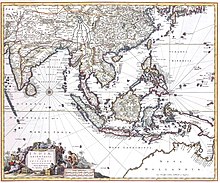| History of Indonesia |
|---|
 |
| Timeline |
|
|
Dalem Ketut was a king ( Dalem) of Bali who ruled at an uncertain time during the age of the Javanese Majapahit Empire (1293-c. 1527). While first a vassal ruler under the Majapahit kings, he later emerged as the king of a separate island realm. He was also known under the names Sri Smara Kepakisan or Tegal Besung. Dewa Tegal Besung is the earliest deified ruler who is honoured at the Pura Padharman Dalem Gelgel, the most important shrine at the central Balinese temple Pura Besakih. [1]
Shift of royal seat
According to the 18th-century chronicle Babad Dalem, Dalem Ketut was the youngest son of the immigrant Javanese Sri Aji Kresna Kepakisan, who was established as Majapahit vassal after the Javanese conquest of Bali in 1343. When his father died he was succeeded in his palace in Samprangan by his eldest son Dalem Samprangan, while Ketut spent his time as a gambler. Since Dalem Samprangan quickly proved incompetent to rule, Ketut was persuaded to take royal titles and establish a new palace ( puri) in Gelgel, close to the south coast. The old Samprangan palace lapsed into obscurity, while the power and prestige of Gelgel rose. The late text Babad Bhumi alleges that he was established in Bali in the Saka year 1378 (AD 1456). [2] However, a charter from Badung mentions another lord, a sang adipati (Majapahit regent) called Sang Arya Gajah Wengker who received tributes from drylands and taxes from the sawah fields in the year 1468. [3]
Reign
The Babad Dalem chronicle relates that Dalem Ketut twice visited Majapahit, at the first occasion meeting the king Hayam Wuruk (1350–1389). [4] The account is anachronistic, since it is also asserted that Dalem Ketut was alive at the time when Majapahit collapsed, an event historically dated in the early 16th century. Through this event, Bali remained as a daughter kingdom of Majapahit, a condition which still has a deep symbolic significance for the self-perception of the Balinese. At the end of his life Dalem Ketut was visited by a Brahmin from Kling ( India) who recognized the face of the king as the same as the countenance of Mahadewa, the God of the mountain Gunung Agung. The priest prophesied the death of Dalem Ketut, which occurred in a supernatural way; the king disappeared without leaving a trace. [5]
Family and succession
Dalem Ketut left six sons:
- Dalem Baturenggong
- Dewa Gedong Arta
- Dewa Nusa
- Dewa Anggungan, later banished from his caste
- Dewa Bangli
- Dewa Pagedangan
Of these offspring, the last five are mentioned in the Babad Dalem as being sons of Dewa Tegal Besung, whom the scholar C.C. Berg identified with Dalem Ketut, but who is sometimes held to be the ruler's half-brother. [6] The eldest son Dalem Baturenggong succeeded to the throne and inaugurated a period of major political expansion in this part of Indonesia. [7] The anachronisms in the traditional accounts makes it difficult to establish the historical status of Dalem Ketut, but if he survived the fall of Majapahit he would have flourished in the early 16th century. [8]
See also
References
- ^ David Stuart-Fox, Pura Besakih; Temple, religion and society in Bali. Leiden: KITLV Press 2002, p. 118.
- ^ Candrasangkala [1], p. 62.
- ^ V.E, Korn, Het adatrecht van Bali. 's-Gravenhage: Naeff 1932, p. 25.
- ^ W.A. Hanna, Bali Chronicles, Singapore: Periplus 2004, p. 25.
- ^ C.C. Berg, De middeljavaansche historische traditië. Santpoort: Mees 1927, pp. 123-9.
- ^ Tjokorda Raka Putra, Babad Dalem. Warih Ida Dalem Sri Aji Kresna Kepakisan. Klungkung: Pustaka Bali Post 2016, p. 57; C.C. Berg 1927, pp. 123-9
- ^ Adrian Vickers, Bali: A paradise created. Berkeley: Periplus 1989, p. 41.
- ^ Cf. Henk Schulte Nordholt, The spell of power: A history of Balinese politics. Leiden: KITLV Press 1996, p. 23.